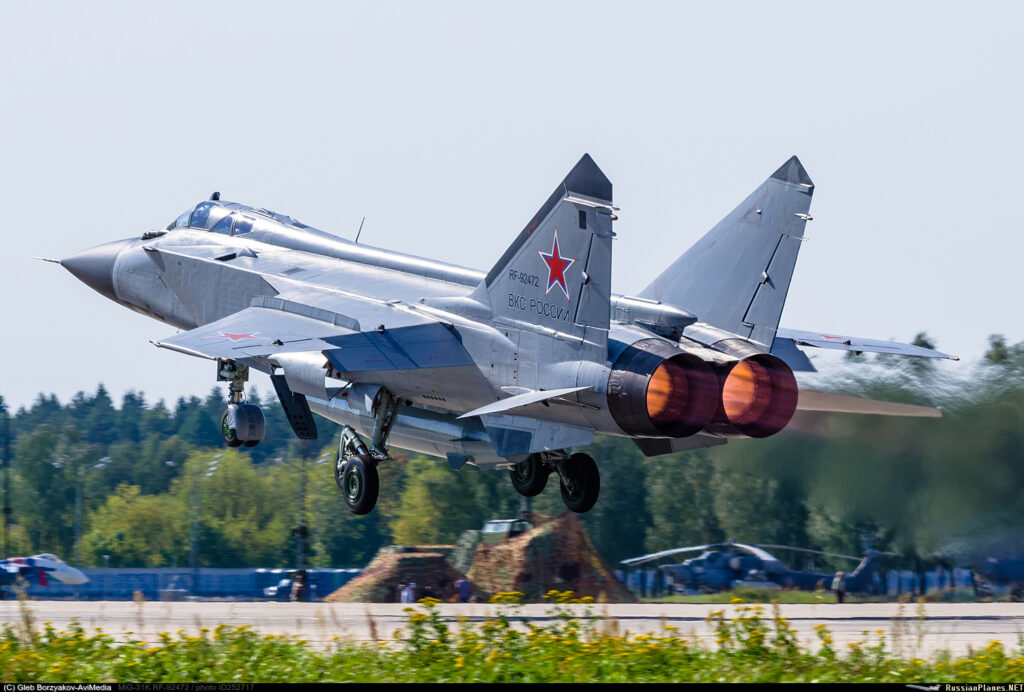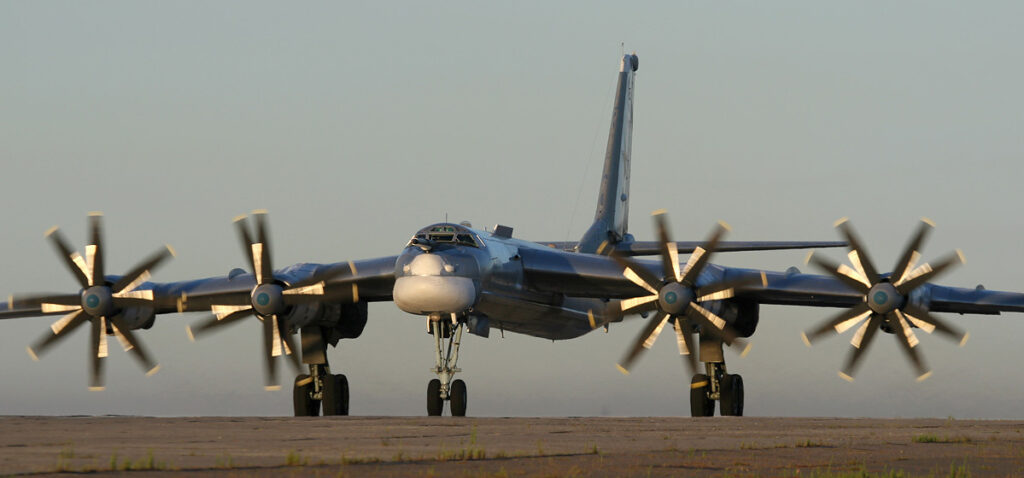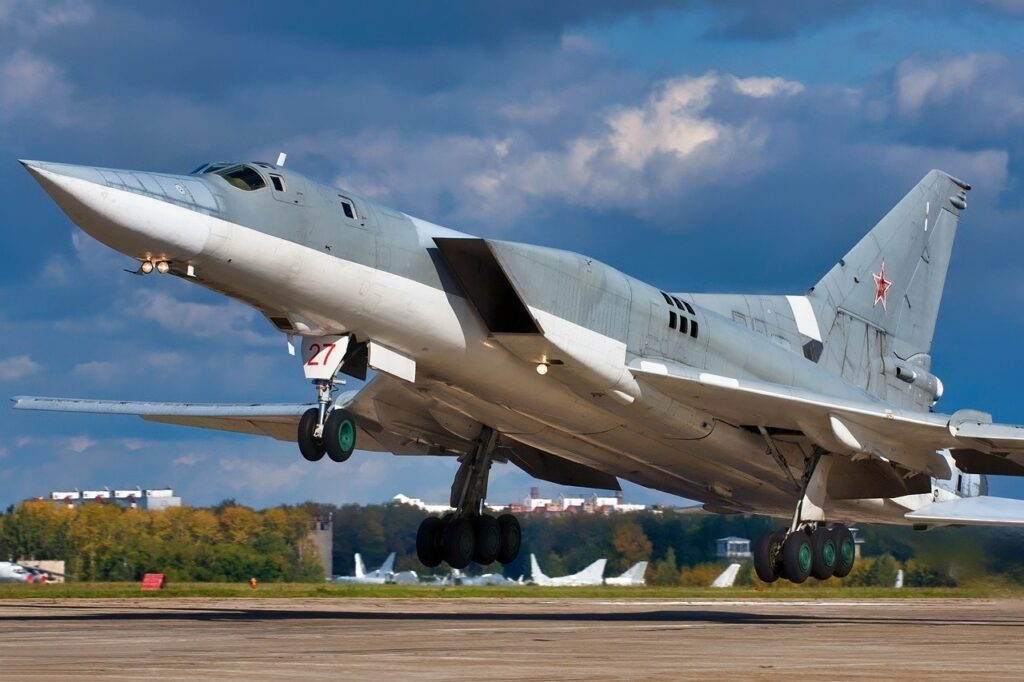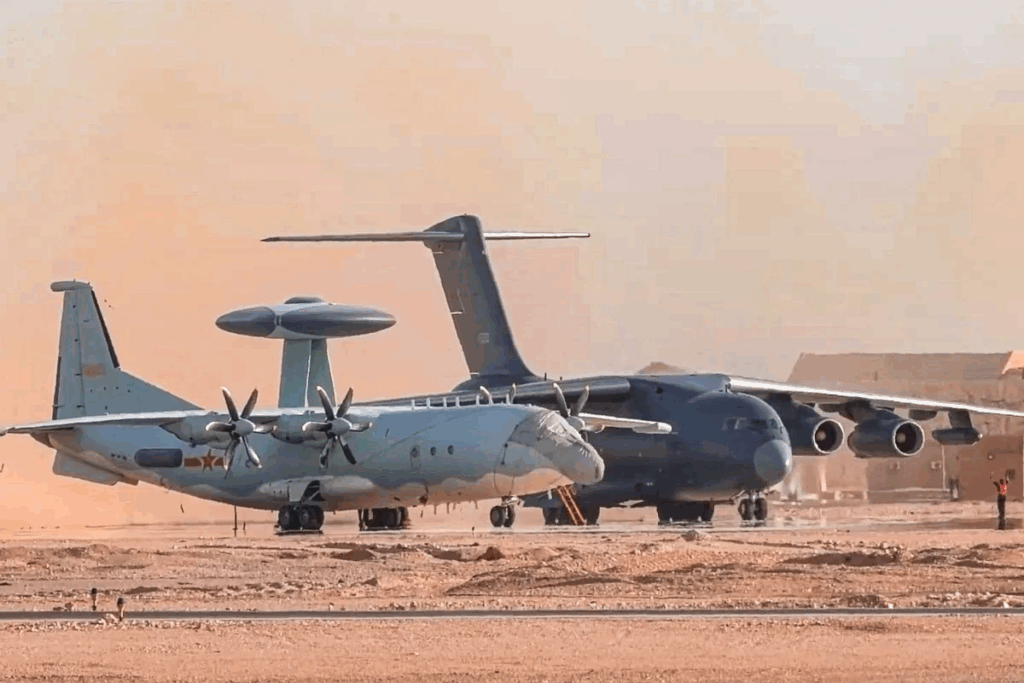The Russian Aerospace Forces (VKS) rely heavily on a fleet of aging, Soviet-era aircraft to project power, conduct long-range strikes, and defend its vast airspace. While these platforms – notably the Tu-95MS strategic bomber, the Tu-22M3 long-range bomber, and the MiG-31 interceptor – have seen extensive service in the ongoing war in Ukraine, they share a critical vulnerability: Russia can no longer produce them. This irreplaceability, coupled with recent successful Ukrainian drone attacks deep within Russian territory, highlights a severe and growing strategic problem for Moscow, diminishing its aerial combat capabilities and long-range strike potential with each loss.
The Soviet Legacy and Russia’s Manufacturing Quandary
The Tu-95MS, Tu-22M3, and MiG-31 are all products of the Soviet era, designed and mass-produced during a period of immense industrial might and a vast, integrated military-industrial complex. Following the collapse of the Soviet Union in 1991, Russia’s defense industry underwent a dramatic decline. Production lines for many complex systems ceased, specialized factories were repurposed or closed, and the invaluable human capital – engineers, technicians, and skilled laborers – dispersed.
Today, Russia faces insurmountable challenges in restarting the full-scale production of these specific aircraft types. The reasons are multifaceted and deeply intertwined with the post-Soviet economic realities and the current geopolitical isolation imposed by international sanctions:
- Lost Production Lines and Infrastructure: The physical machinery, tooling, and dedicated assembly lines for these aircraft simply no longer exist in their original, fully operational state. Rebuilding such infrastructure from scratch would require colossal financial investment and many years, if not decades, of effort. For the MiG-31, production ceased in 1993, and sources confirm that the necessary factories, production lines, and specialized equipment are absent. Similarly, the long production runs of the Tu-95MS and Tu-22M3 ended decades ago, making a complete restart virtually impossible.
- Disintegrated Supply Chains: During the Soviet era, components for these complex aircraft often came from across the Soviet republics, including what is now independent Ukraine. Post-1991, these integrated supply chains fragmented. Even for components produced within Russia, the original manufacturers might no longer exist, or their capabilities have significantly degraded. Crucially, modern military aircraft, even older designs, rely on advanced avionics, microelectronics, and specialized alloys. Western sanctions imposed after 2014 and significantly expanded after the 2022 invasion have severely restricted Russia’s access to critical imported components, particularly semiconductors, integrated circuits, and high-precision machinery needed for advanced manufacturing. This directly impacts the ability to not just build new aircraft, but even to maintain existing ones, as parts for key systems like radar, navigation, and targeting become scarce.
- Outdated or Lost Technical Documentation: Over decades, technical documentation, blueprints, and manufacturing tolerances for these legacy aircraft can become outdated, incomplete, or even lost. Re-creating these comprehensive design packages would be a monumental engineering task, requiring reverse-engineering existing airframes and engines, which is time-consuming and expensive. Bulgarian Military, for instance, notes that much of the MiG-31’s original production documentation is “outdated, often lost, or not maintained.”
- Brain Drain and Loss of Skilled Labor: The highly specialized workforce required to design, build, and maintain these complex aircraft – including aerodynamicists, materials scientists, avionics engineers, and master craftsmen – has significantly diminished since the Soviet era. Many skilled workers retired, left the industry, or emigrated. Rebuilding this human capital base through education and training programs would take many years and cannot be expedited by wartime demands alone.
- Engine Production Bottlenecks: Specific engines for these aircraft are particularly problematic. The MiG-31 is powered by two unique Solovyov D-30F6 afterburning turbofan engines. These engines have a notoriously short service life (reportedly as little as 300 flight hours) and their production ceased decades ago. While Russia had stockpiled some spares, maintaining a large fleet of MiG-31s becomes a severe challenge as engines reach their service limits. Restarting D-30F6 production is deemed “not at all certain — first technologically, and second financially.” The same issues apply to the engines of the Tu-95MS (NK-12) and Tu-22M3 (NK-25), albeit with potentially different service life characteristics.
Consequently, any loss of a Tu-95MS, Tu-22M3, or MiG-31 is essentially an irreparable loss for the Russian Air Force, as these aircraft cannot be replaced by new builds. Russia must rely on cannibalizing existing airframes in storage (many of which are in poor condition) or on a shrinking pool of operational aircraft.

Role of Tu-95MS, Tu-22M3, and MiG-31 in the Ukraine War: Pillars of Russian Air Power
These three aircraft types have played distinct but vital roles in Russia’s military campaign against Ukraine, often serving as critical components of its long-range strike capabilities and air defense network.
Tu-95MS: The Bear-H, Strategic Cruise Missile Carrier
The Tu-95MS, known to NATO as “Bear-H,” is an aging but still highly relevant strategic bomber. It is the backbone of Russia’s long-range conventional and nuclear strike capability. Despite its turboprop engines and origins dating back to the 1950s, modern upgrades have allowed it to remain a potent platform:
- Long-Range Cruise Missile Carrier: The primary role of the Tu-95MS in the Ukraine war has been as a launch platform for long-range air-launched cruise missiles (ALCMs), predominantly the Kh-101 (and older Kh-55/Kh-555 variants). These missiles are launched from well beyond Ukrainian airspace, often hundreds or thousands of kilometers from the front lines, keeping the bombers safe from most Ukrainian air defenses. A single Tu-95MS can carry up to 16 Kh-101 cruise missiles, either internally or on external pylons. These missiles are highly destructive and have been used extensively to target Ukraine’s energy infrastructure, military installations, and cities, aiming to degrade Ukraine’s ability to resist and to break civilian morale.
- Strategic Deterrence: As a nuclear-capable bomber, the Tu-95MS remains a critical component of Russia’s strategic nuclear triad, serving as a visible symbol of its nuclear deterrence posture. Even when flying conventional missions over Ukraine, their very presence carries a psychological weight, signaling Russia’s intent and capabilities.
- Continuous Pressure: The Tu-95MS fleet has been used to maintain constant pressure on Ukraine, forcing Kyiv to expend valuable air defense resources (missiles like Patriot, NASAMS, IRIS-T) to intercept incoming cruise missiles. This constant expenditure drains Ukrainian stockpiles and opens up vulnerabilities for other Russian aerial attacks.
Tu-22M3: The Backfire, Supersonic Bomber and Kh-22 Carrier
The Tu-22M3, or “Backfire,” is a supersonic long-range bomber with variable-sweep wings, giving it high speed and considerable range. Unlike the Tu-95MS, it is typically associated with a different type of munition:
- Kh-22/Kh-32 Missile Carrier: The Tu-22M3 has been primarily used to launch the heavy, Cold War-era Kh-22 (AS-4 Kitchen) anti-ship missile, often repurposed for land attack. More recently, it has also deployed the modernized Kh-32, which is externally similar but offers improved performance and a dual-role capability. These missiles are notoriously difficult for older air defenses to intercept due to their high speed (Mach 4 in terminal phase for Kh-22) and their steep terminal dive. While often inaccurate when used against ground targets, they are highly destructive due to their large warhead, causing significant civilian casualties.
- Standoff Strikes: Like the Tu-95MS, the Tu-22M3 conducts standoff strikes from deep within Russian airspace, minimizing its exposure to Ukrainian air defenses. This tactic allows Russia to hold vast swathes of Ukraine at risk without putting its valuable bomber assets at direct risk over the front lines.
- Tactical Bombing (limited): While designed for strategic roles, there have been instances of Tu-22M3s operating closer to the front lines for conventional bombing, particularly in the early phases of the war, though this has become rarer due to Ukrainian air defense improvements.
MiG-31: The Foxhound, Supersonic Interceptor and Kinzhal Carrier
The MiG-31 “Foxhound” is a high-speed, high-altitude interceptor, originally designed to defend vast Soviet airspace against enemy bombers and cruise missiles. In the Ukraine war, it has found a new, critical offensive role:
- Kinzhal Hypersonic Missile Carrier (MiG-31K): The most significant role of the MiG-31 in the current conflict is its modification to the MiG-31K variant, capable of carrying and launching the Kh-47M2 Kinzhal aeroballistic hypersonic missile. The MiG-31’s exceptional speed (Mach 2.83) and high operational altitude (up to 21 kilometers) enable it to accelerate the Kinzhal to hypersonic speeds before launch, making the missile extremely difficult for even advanced air defenses to intercept. Each MiG-31K typically carries one Kinzhal missile. These strikes are often aimed at high-value Ukrainian targets like command centers, airfields, Patriot batteries, and critical infrastructure. The MiG-31K is considered a linchpin in Russia’s rapid, long-range strike doctrine.
- Long-Range Air Defense/Air Superiority: Standard MiG-31BM variants also play a crucial role in air defense and air superiority. Equipped with powerful Zaslon-M radars and very long-range R-37M air-to-air missiles, MiG-31s can patrol vast areas, creating “no-fly zones” for Ukrainian aircraft far from the front lines. They can engage Ukrainian fighters and even cruise missiles at extreme ranges, posing a constant threat to Ukrainian aviation and forcing Ukrainian pilots to operate at lower altitudes or use terrain masking.
- Psychological Weapon: The mere takeoff of a MiG-31K from Russian airfields often triggers nationwide air raid alerts in Ukraine, as it signifies the potential for a Kinzhal strike anywhere in the country. This psychological pressure is a significant part of Russia’s strategy.
The Impact of Recent Ukrainian Drone Attacks: Irreparable Losses
In late May and early June 2025, Ukraine executed a series of audacious and highly effective drone attacks deep into Russian territory, specifically targeting strategic airbases housing these irreplaceable aircraft. These operations, reportedly orchestrated by the Security Service of Ukraine (SBU) and dubbed “Operation Spider’s Web,” demonstrated Ukraine’s growing long-range strike capabilities and highlighted Russia’s vulnerability.
Key Incidents and Reported Losses (May-June 2025):
- June 1, 2025 – Operation Spider’s Web: This was a coordinated, large-scale drone attack targeting multiple Russian strategic airbases, including Belaya (Irkutsk Oblast), Dyagilevo (Ryazan Oblast), Ivanovo Severny (Ivanovo Oblast), Olenya (Murmansk Oblast), and Ukrainka (Amur Oblast).Ukrainian officials claimed to have hit over 40 Russian military aircraft, with the SBU later claiming that 34% of Russia’s strategic cruise missile carriers were rendered inoperable, inflicting an estimated $7 billion in damage.
- Tu-95MS Losses: Satellite imagery and open-source intelligence analysis following the June 1 attack confirmed significant damage. Reports indicated the destruction of at least three Tu-95MS bombers and damage to at least one more at Olenya airbase. Some assessments placed the total destroyed or damaged Tu-95MS numbers even higher across various bases. Footage released by the SBU showed drones striking the wings of Tu-95MS bombers near fuel tanks.
- Tu-22M3 Losses: Operation Spider’s Web also severely impacted the Tu-22M3 fleet. Satellite imagery confirmed the destruction of at least one Tu-22M3 bomber at Belaya airbase (Irkutsk Oblast), over 4,000 km from the Ukrainian border – marking Ukraine’s deepest strike into Russian territory. Further analysis suggested up to three more Tu-22M3s might have been destroyed or significantly damaged across the targeted airfields. The SBU released dramatic FPV drone footage showing a direct hit on a Tu-22M3 at Belaya.
- MiG-31 Losses (Less Confirmed): While the primary targets of “Spider’s Web” were strategic bombers and A-50 AWACS aircraft, some reports from that period, though less confirmed by imagery, suggested that fighter aircraft could also have been hit.
- June 9, 2025 – Savasleyka Airfield Attack: Ukrainian Armed Forces reported an attack on the Savasleyka airfield (Nizhny Novgorod region), claiming to have hit at least one MiG-31 and one Su-30/34 fighter. While Russian sources tend to downplay or deny such claims, Ukrainian military analysts highlighted that if confirmed, the loss of even a single MiG-31, particularly a MiG-31K variant (Kinzhal carrier), would be an irreparable blow given Russia’s inability to produce new units. From this military facility, MiG-31K fighters regularly take off, which are carriers of Kinzhal aeroballistic missiles.
The Profound Effect of Destruction: Irreplaceable Assets
The destruction or severe damage of these aircraft, particularly the recent losses in May-June 2025, has profound and lasting consequences for the Russian Aerospace Forces:
- Irreplaceable Losses: As established, Russia cannot produce new Tu-95MS, Tu-22M3, or MiG-31 aircraft. Each loss is permanent and depletes a finite strategic asset. Unlike modern fighter jets or tanks, which might have ongoing production or deep reserves, these aircraft are relics of a bygone era of Soviet industrial capacity. This “irreplaceability” is a key theme emphasized by Ukrainian and Western intelligence.
- Diminished Long-Range Strike Capability: The losses directly impact Russia’s ability to conduct long-range missile strikes against Ukraine.
- Fewer operational Tu-95MS means fewer Kh-101 cruise missiles can be launched in a single wave, potentially reducing the intensity and frequency of Russia’s mass missile attacks on Ukrainian infrastructure and cities.
- Fewer Tu-22M3 bombers mean a reduced capacity to launch Kh-22/Kh-32 missiles, which, despite their inaccuracy, cause immense destruction and are difficult for Ukraine’s older air defenses to counter.
- The loss of a MiG-31K is particularly impactful, as it directly reduces the number of platforms capable of carrying the Kinzhal hypersonic missile, a weapon frequently used to target high-value assets and instill psychological terror. The MiG-31K is a specialized modification, a rare commodity impossible to replicate. Each such loss chips away at Russia’s image as a “hypersonic superpower.”
- Strain on the Remaining Fleet: The remaining operational aircraft will face increased operational tempo and strain, accelerating their wear and tear. This will exacerbate maintenance challenges, as a dwindling pool of spare parts and skilled technicians struggles to keep the fleet airborne. This problem is particularly acute for the MiG-31 due to its D-30F6 engines’ short service life. Russia might be forced to pull aircraft from storage, but many are in poor condition, suitable mainly for cannibalization, and the refurbishment process is slow and costly.
- Psychological and Strategic Humiliation: Striking airbases deep within Russian territory, using covertly smuggled drones, delivers a significant psychological blow to the Kremlin. It shatters the perception of Russia’s “strategic depth” and shows that even its most vital strategic assets, often linked to its nuclear deterrent, are vulnerable. This “web of humiliation and strategic losses” as one analyst described it, forces Russia to divert resources to air defense of its own territory, which might otherwise be used on the front lines. The Tu-95MS burning on a runway sends a powerful message.
- Forced Reorganization and Dispersal: The success of these drone attacks will likely force Russia to further disperse its strategic aviation assets across its vast territory. While this might offer some protection, it also creates logistical challenges, increasing transit times for missions and potentially complicating command and control. Many Russian airfields lack the necessary infrastructure (long runways, hardened shelters) for heavy bombers like the Tu-95MS and Tu-22M3, limiting viable dispersal options.
- Impact on Air Defense Strategy: For the MiG-31, the losses affect not only offensive Kinzhal operations but also Russia’s overall air defense umbrella. Fewer operational MiG-31s mean potential gaps in Russia’s ability to intercept threats over its own territory or to provide long-range air superiority coverage for its forces. The MiG-31’s unique long-range radar and missile capabilities are not easily replicated by other Russian fighters.

The Broader Picture: Sanctions, Adaptation, and Asymmetric Warfare
The inability to produce new Tu-95MS, Tu-22M3, and MiG-31 aircraft is a direct consequence of the post-Soviet industrial decline exacerbated by comprehensive Western sanctions. These sanctions have choked Russia’s access to vital dual-use components, advanced manufacturing equipment, and specialized technologies required for modern aerospace production. While Russia attempts to circumvent sanctions through third countries (like Kazakhstan and China) or by ramping up domestic production of some less complex items, the sheer scale and technological complexity of building new strategic bombers or advanced interceptors from scratch is beyond its current capabilities.
Ukraine’s “Operation Spider’s Web” and similar deep strikes represent a masterful demonstration of asymmetric warfare. By using relatively inexpensive, often commercially available drones (albeit modified for military purposes and integrated with advanced navigation and AI-assisted targeting), Ukraine is able to inflict multi-billion dollar damage on irreplaceable Russian assets. This shifts the cost-exchange ratio dramatically in Ukraine’s favor and forces Russia to confront vulnerabilities it previously considered secure. The tactics employed, such as smuggling drones deep inside Russia in trucks, reveal ingenuity and extensive intelligence gathering, making it harder for Russia to predict and defend against.
In conclusion, the Tu-95MS, Tu-22M3, and MiG-31 are more than just aircraft; they are symbols of Russia’s enduring military might and its strategic aspirations. Their roles in the Ukraine war, from delivering devastating cruise missile strikes to carrying hypersonic weapons and patrolling vast airspaces, have been critical. However, their Soviet vintage has become their Achilles’ heel. With no capacity for new production, each loss inflicted by Ukraine’s increasingly sophisticated drone capabilities constitutes an irreplaceable blow. The recent destruction of these vital aircraft, particularly the Tu-95MS and Tu-22M3 during “Operation Spider’s Web” in early June 2025 and the potential loss of a MiG-31 at Savasleyka, underscores a profound and irreversible degradation of Russia’s long-range air power. This will likely force a re-evaluation of Russia’s aerial strategy, increase strain on its remaining fleet, and serve as a stark reminder of the enduring impact of sanctions and the evolving nature of modern warfare.



